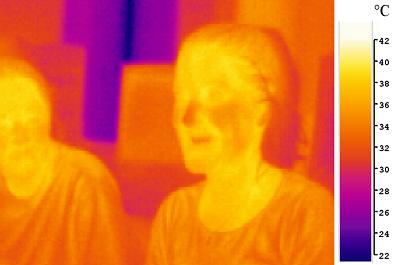It is said that such technology has many and varied application possibilities in detecting terrorist activity, similar to night vision, target identification and missile tracking

Scientists at the Center for Quantum Devices at the McCormick School of Engineering at Northwestern University demonstrated for the first time high-level infrared imaging, based on a type II superlattice, which exists at a wavelength 20 times longer than visible light.
The center's scientists, led by researchers Manijeh Razeghi and Walter P. Murphy, professors of electrical engineering and computer science, say that such technology has many and varied application possibilities in detecting terrorist activity, similar to night vision, target identification and missile tracking.
Any object, including the human body, that has a temperature close to room temperature, actively emits a long wavelength (about ten microns) of infrared radiation (LWIR). Tracking this radiation using high-speed infra-red imaging can help detect spectral profiles of targets or objects at night when no other source of light is visible. This imaging also has a possible application in medicine when the detection of very hot or cold points inside the body can indicate inflammation, internal hemorrhages and even pathological areas, such as cancerous tissues. In the application of this method, the main components are photodetectors based on the combined material mercury-cadmium-telluride (HgCdTe, MCT)) and photoconductors of the quantum well type (quantum well photoconductors, QWIP). These two components have limitations that accelerated the research for alternative technologies. Type II superlattices of indium-arsenide/gallium-antimonide (InAs/GaSb), first proposed by Nobel laureate Leo Esaki in 1973, became a possible application in infrared imaging in 1987.
Comprehensive imaging of this type, at a high level, became possible only in the nineties, when epitaxial growth methods for the preparation of semiconductors, such as molecular beam epitaxy, became sufficiently advanced. "The type II superlattice will become the next generation of infrared imaging materials and will replace the MCT method," says the researcher. "The previous method has many limitations, especially in the longer range of the infrared wavelengths, an essential field for missile tracking."
The research group recently developed a new superlattice, called the M-type structure, which brought the efficiency of Group II superlattices to an entirely new level. This new structure is capable of detecting very small illuminance while maintaining high optical efficiency and producing an electronic noise level that is ten times smaller than the original structures. A focal plane array of the LWIR type and with a resolution of 320×256 pixels prepared with the help of this new material was able to differentiate between different temperature zones, the difference between which is only about 0.02 degrees Celsius. The facility was able to detect about 74 percent of the amount of photons, a level similar to other advanced imaging methods.

5 תגובות
There have been IR cameras for many years that are based on sensors that pick up infrared radiation emitted by hot bodies (for example, people, vehicles, etc.) and display a clear image on a screen that shows the landscape according to the level of heat emission of each body and structure - and they are not based at all on amplification starlight
So again I ask - what exactly is the innovation here?
The process is that photodetectors pick up the infra-red radiation that is emitted from bodies that are in the environment and turn them into an image that is later converted into an image on a visible light screen (the different intensities of the infra-red radiation are converted to different colors in the visible light on the LCD screen)
Night vision is an artificial amplification of visible light, such as the moon, stars and distant light sources.
The whole idea of night vision is that black and white light sensors are used (in the range of all visible light; no green, red or blue filters) which are much more sensitive than our color receptors in the eye
What is the difference compared to IR cameras that exist today in the world for night vision?
To what working temperature should the M mesh be lowered for it to work effectively
So the electron noise level will be negligible.